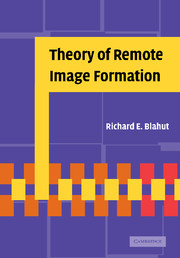Book contents
- Frontmatter
- Contents
- Preface
- Acknowledgements
- 1 Introduction
- 2 Signals in one dimension
- 3 Signals in two dimensions
- 4 Optical imaging systems
- 5 Antenna systems
- 6 The ambiguity function
- 7 Radar imaging systems
- 8 Diffraction imaging systems
- 9 Construction and reconstruction of images
- 10 Tomography
- 11 Likelihood and information methods
- 12 Radar search systems
- 13 Passive and baseband surveillance systems
- 14 Data combination and tracking
- 15 Phase noise and phase distortion
- References
- Index
9 - Construction and reconstruction of images
Published online by Cambridge University Press: 19 August 2009
- Frontmatter
- Contents
- Preface
- Acknowledgements
- 1 Introduction
- 2 Signals in one dimension
- 3 Signals in two dimensions
- 4 Optical imaging systems
- 5 Antenna systems
- 6 The ambiguity function
- 7 Radar imaging systems
- 8 Diffraction imaging systems
- 9 Construction and reconstruction of images
- 10 Tomography
- 11 Likelihood and information methods
- 12 Radar search systems
- 13 Passive and baseband surveillance systems
- 14 Data combination and tracking
- 15 Phase noise and phase distortion
- References
- Index
Summary
Image formation is the task of constructing an image of a scene when given a set of noisy data that is dependent on that scene. Possibly some prior information about the scene is also given. Image formation also includes the task of refining a prior image when given additional fragmentary or degraded information about that image. Then the task may be called image restoration.
In the most fundamental problem of image restoration, one is given an image of a two-dimensional scene, but the detail of the image, in some way, is limited. For example, the image of the scene may be blurred or poorly resolved in various directions. Sophisticated signal-processing techniques, called deconvolution or deblurring, can enhance such an image. When the blurring function is not known but must be inferred from the image itself, these techniques are called blind deconvolution or blind deblurring. Problems of deconvolution are well known to be prone to computational instability, and great care is needed in the implementation of deconvolution algorithms.
Another task of image construction is estimating an image from partial knowledge of some of the properties of the image. An important instance of this task is estimating an image from the magnitude of its two-dimensional Fourier transform.
- Type
- Chapter
- Information
- Theory of Remote Image Formation , pp. 287 - 320Publisher: Cambridge University PressPrint publication year: 2004

